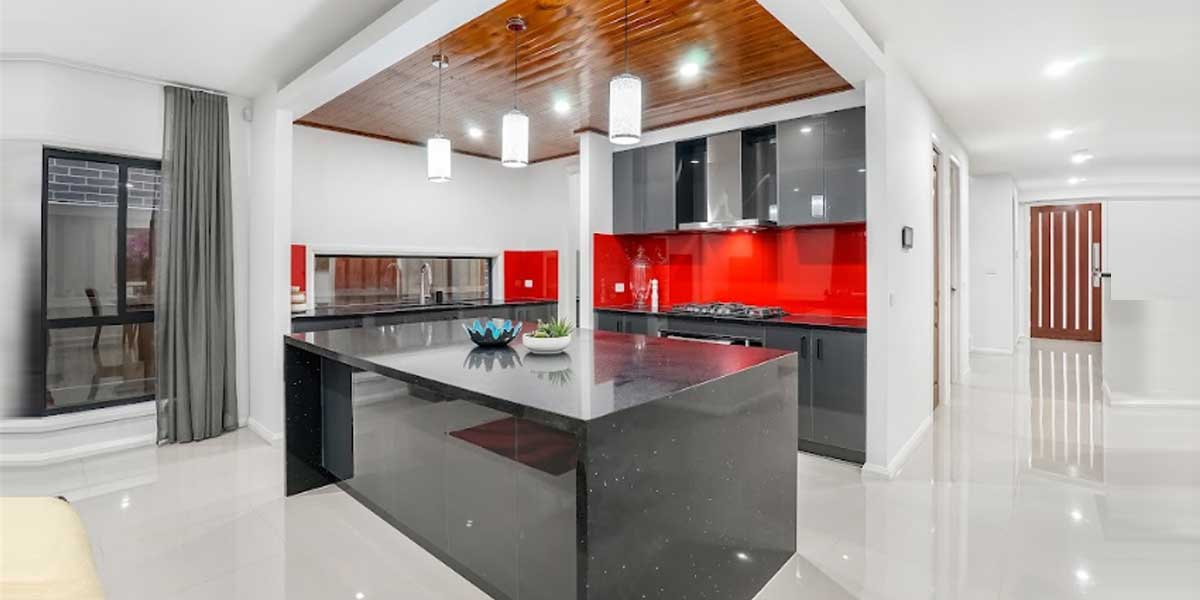As a versatile product, glass can be used in multiple ways in a home. Glass provides partial transparency, connects spaces without a wall and allows the design and colour of your home show while making it lit with natural light.
Innovation in glass for home use

One of the most widely used material in the architectural industry, glass tops the list when looking for iridescent materials for home. There are multiple of types of glasses innovatively curated to be used in home interiors.
Patterned or textured glass: From colourful patterns embossed on their surface to plain textures, this type of glass is widely used in spaces that require privacy and yet need light. The texture allows natural light to flow in while preventing a clear view of objects or people behind.
Spandrel glass: This type of glass is opaque and reflective in nature. It comes in various colours and is largely used to cover up spaces to give a neat look. Five times stronger than traditional glass, this is widely used on kitchen cabinets and walls.
Security glass: Ideal for coffee tables or countertops, this glass is laminated or toughened to keep itself together in case of a disaster. Widely preferred by those making a home for its strength, this glass can be works well in home interiors at various places.

Stained glass: A type of coloured glass used in homes for decorative purposes. Curated by using coloured glass together to form floral, contemporary, figurative, or abstract designs, pieces are joined together for use in cabinets, windows or doors to create an aesthetic appeal.
Connecting and defining spaces
‘Inviting the outside in’, is a phrase made true for homes with the use of glass. One of the most important component of home interiors is making home inviting for the outdoors and for people aesthetically. This can be largely achieved by the use of glass.
Use of glass in home interiors creates an illusion of space. It allows designers to create an augment of space that link it with the outdoors. Glass windows allow natural light to flow in giving you a clear view of the outside. It brightens up a space naturally and allows those who reside in this home to soak up the sun while being indoors with a view of the nature around them. Technology has also given way for use of glass in roofs and floors.
Glass of various textures, colours and treatments also are moulded in such a manner that they have the power to transform a space. For example, a kitchen can go from basic to fab with the use of glass on treated glass on its cabinets giving it a neat aesthetic and modern look. Large windows, textured glass stairways and doors make for defining features of a home.
“Glass changes the dynamics of a space! Glass is that ‘transparent wall’ that enhances the visual functionality of spaces. It provides flexibility–a combination between providing safety and blurring the boundaries between the inside and the outside. In other words, large windows of glass opening to the outside nature or landscape not only create an ambience by allowing natural light inside but also foster a visual connection between the sheltered building occupants and the outside. With a wide variety of textures available in glass, fluted glass helps create a theatrical effect in the interiors” says Shalini Chandrashekar, Co-Founder and Principal Architect, Taliesyn – Design and Architecture.
Clear glass, in its natural and basic form is widely used in interiors for décor. Using glass for décor in a space indicates care and luxury. It defines an eye for detail while also allowing transparency which uplifts the theme.
Glass, a sustainable route to home interiors

Waste, over utilisation of energy resources and synthetic materials are some of the few reasons that is causing harm to the planet. Glass can come as a saviour while used in home interiors and can pave a path for homes to be sustainable in their structure.
Glass is a material that can be endlessly recycled without the loss of quality. Interior designers can connect with communities that collect and recycle glass from various landfills, waste dumps, etc., and utilise the same for home interiors. This will help such communities look for larger quantities of waste and increase the demand for recycled glass. It’s a win-win for everyone and a relief to the planet.
Clear glass allows natural light to flow inside a home. A form of technologically treated glass, with reflective properties allows heat to reflect back keeping homes cool. In both scenarios, glass significantly helps in reducing the consumption of artificial energy sources that illuminate the home or cool it down. On similar lines, energy efficient glasses that are eco-friendly in nature prevent heat from escaping the home keeping it warm in cold environments reducing the use of electronics to heat up the house.
According to Rakhee Bedi Kumar, Founding Principal, Rakhee Shobhit Design Associates (RSDA), “In a country like India, where most parts have a tropical climate, glass in green buildings needs to be carefully mapped and implemented. The focus on green buildings constitutes energy-efficient facades; together with technological advancements, “intelligent” glass facades have been developed, adapting to the external and internal climatic conditions”.

“The fact that glass is a recyclable material makes it an essential component in designing green buildings. When used carefully, glass can optimise the energy efficiency of the building. Along with tangible benefits, it also helps enhance the indoor air quality. Glass facades allow adequate natural light to enter the house, benefiting the general health and well-being of the occupants” she adds.
Glass is a versatile material that can be using in home interiors from balconies to the kitchen, from bathrooms to the windows. With advanced technology, various treatments and textures on glass allows it be used in multiple ways. As an eco-friendly material, it could be key in building sustainable homes and can be the future of interior design.


















